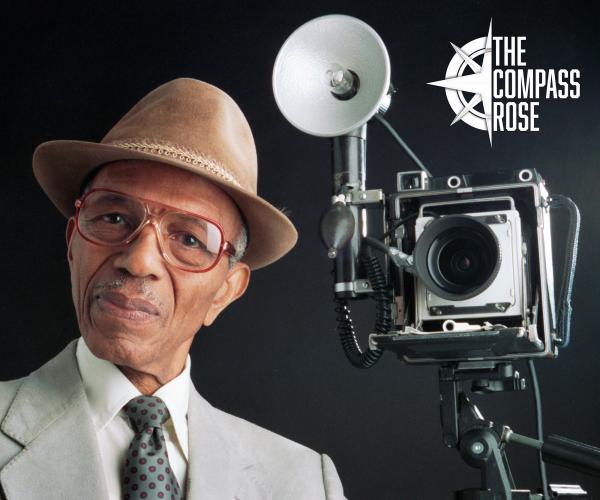
by Sara Pezzoni


by Sara Pezzoni
The purpose of The Compass Rose is to raise awareness of Special Collections' resources and to foster the use of these resources. The blog series also reports significant new programs, initiatives, and acquisitions of Special Collections.
In celebration of Black History Month, this blog post commemorates Calvin Littlejohn, the legendary Fort Worth photographer, gardener, civic developer, publisher, and inventor.
Calvin Littlejohn (1909-1993) was one of Texas' leading African American community photographers from the 1940s through the early 1990s. Littlejohn was born in Cotton Plant, Arkansas, in 1909 and was raised by his grandparents, who were former slaves. In college, he studied commercial art at Philander Smith College in Little Rock, Arkansas. He moved to Texas in 1934 where he helped run a photography studio in Fort Worth with G. B. Grimble, beginning his lifelong career in photography and serving the Fort Worth community (Selcer, pgs. 273, 298). His background in art led him to a job with the Fort Worth school district, teaching in the industrial arts department at the James E. Guinn School (Sanders, p. 8; Canning, 1988). Littlejohn refined his photographic skills further when he enlisted in the Army in 1942 and served as the official photographer for and director of a segregated recreational facility at Fort Leonard Wood in Missouri until the end of World War II (Weiner, 1989; Tyson, 1990). After the war, Littlejohn was assigned to I. M. Terrell High School, Fort Worth's (and Tarrant County’s) only Black high school at the time, where he served as the official photographer for the school and took photos for the school newspaper and yearbook (Sanders, pgs. 5, 8).
Below is a series of uncredited Fort Worth Star-Telegram photos, presumably taken by Calvin Littlejohn, who worked as I. M. Terrell High School's official photographer and as a freelance photographer for the Star-Telegram.
Littlejohn’s body of work is considered the most comprehensive documentation of life in Fort Worth's African American community during the Jim Crow and Civil Rights eras—a time when mainstream newspapers rarely published photos of Black citizens and white photographers wouldn't take pictures in Black schools. Littlejohn had a ubiquitous presence in Fort Worth and focused on capturing everyday life—photographing doctors, lawyers, retailers, hotels, High School activities, community/social events, church activities, and entertainers. Littlejohn also covered crucial moments during the Civil Rights Movement, including visits to the Dallas and Fort Worth areas by key leaders like Dr. Martin Luther King Jr., Thurgood Marshall, Paul Robeson, and A. Phillip Randolph.
Although he never set out to be the documentarian of Fort Worth's Black community, Littlejohn captured the best of the community, providing a more realistic and nuanced account of Black life and culture than what was typically portrayed at the time. Littlejohn’s freelance photography for local newspapers like the Fort Worth Mind, Lake Como Monitor, La Vida News, the Fort Worth Press, and the Fort Worth Star-Telegram occupied most of his time, but he was also an accomplished gardener, civic developer, publisher, and inventor.
In "retirement," Littlejohn served as a member of the Near Southeast Citizens Committee and launched a project in 1984 to create four community gardens throughout Fort Worth where residents of these neighborhoods shared the work and the harvest. The project was initially funded with a $5,000 Community Block development grant, which paid for seed, fertilizer, and water (Weiner, 1989). The gardens were located in southeast Fort Worth at 1327 Illinois Avenue, 1001 Maddox Avenue, 122 New York Avenue, and 926 Dashwood Street. Crops included green beans, mustard greens, sweet corn, okra, black-eyed peas, spinach, peppers, onions, bunch beans, and tomatoes (Reeks, 1985). The bountiful harvest was often shared with local senior citizen centers and others in need in the area.
Littlejohn's love for gardening and the science of farming began when he was just 11, when his grandfather became partially paralyzed and put Littlejohn in charge of maintaining his 150-acre Arkansas farm. He was accepted into a local agricultural program and an extension service agent oversaw Littlejohn’s work on his grandfather’s farm for three years, which he spent planting watermelons, cotton, and peanuts (Selcer, 297; Weiner, 1989).
The Near Southeast Citizens Committee’s Urban Gardening Project was recognized as third-place winners of the Neighborhoods USA Award in 1986 in the “Single Neighborhood Physical Needs” category (Millar, 1986) and Littlejohn was honored with a Fort Worth Clean City Star award in 1989, which recognizes “extraordinary efforts by individuals and businesses to keep Cowtown clean” (Weiner, 1989). While these four community gardens established by the Near Southeast Citizens Committee over three decades ago no longer exist, community gardens continue to live on today throughout Fort Worth, including several that are supported by the Tarrant Area Food Bank’s Community Garden Program.
The Calvin Littlejohn Photographic Archive is housed at the Dolph Briscoe Center for American History at the University of Texas at Austin and contains approximately 70,000 film negatives and 55,000 prints (view the collection finding aid here).
To view more photographs of Calvin Littlejohn on the UTA Digital Gallery, visit: https://library.uta.edu/digitalgallery/subject/littlejohn-calvin-1909-1993
--
Sources
Calvin Littlejohn Photographic Archive, circa 1945-1993 [finding aid], Dolph Briscoe Center for American History, The University of Texas at Austin.
Canning, Whit. (1988, November 6). A landmark of education. Fort Worth Star-Telegram, section 1, pgs. 25, 30.
Evans, Christopher. (1993, September 9). Calvin Littlejohn, 84, leaves legacy of photos. Fort Worth Star-Telegram, p. 1.
Reaves, Gayle. (1986, May 30). Plots squashed, but garden idea is still sprouting: Vacant-lot-veggies project trying for national award. Fort Worth Star-Telegram, pgs. 1A-2A.
Reeks, Anne. (1985, June 10). Project turns scrumptious: Communal garden bearing bountiful harvest. Fort Worth Star-Telegram, pgs. 9A-10A.
Sanders, Bob Ray. Calvin Littlejohn: Portrait of a Community in Black and White. TCU Press, 2009.
Selcer, Richard F. A History of Fort Worth in Black and White: 165 Years of African American Life. University of North Texas Press, 2015.
Tyson, Janet. (1990, February 4). The captured light of Calvin Littlejohn: Chronicler of a community. Fort Worth Star-Telegram, section 6, pgs. 3-5.
Weiner, Hollace Ava. (1989, September 29). Vision accomplished: A farmer transforms urban blight into a delight. Fort Worth Star-Telegram, section 1, p. 28.
Add new comment